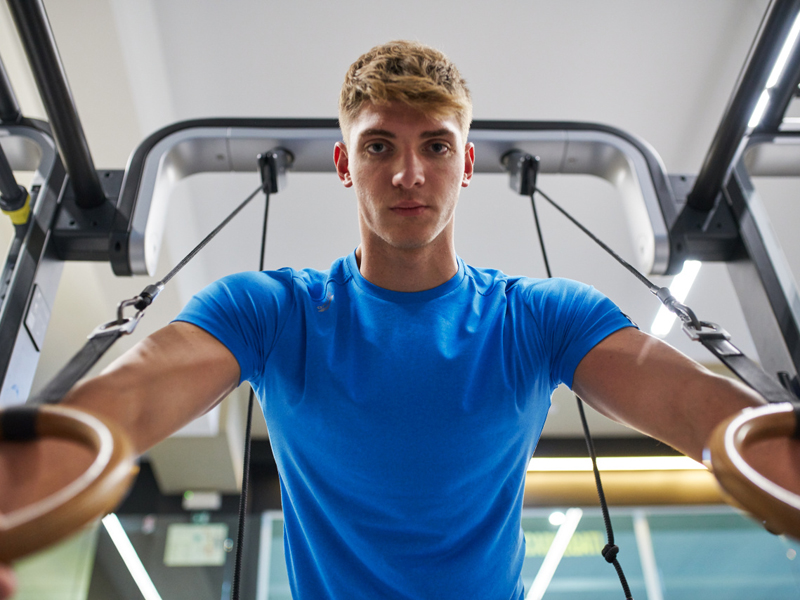Find out why strength training is important for both amateur and professional swimmers.
Would you like to swim faster but you already spend lots of time in the water? Well, you could try training OUT of the water too! Adding “dryland” training to your sessions in the water will allow you to increase the size of your “engine”, build up your muscles, and improve the flexibility and mobility of your joints.
Take note: as well as, not instead of!
If you have to choose between swim training and fitness training, always choose swimming. Why? Try and imagine bodybuilder, who is so strong he can lift really heavyweights, whatever the exercise. Do you think he will also be an extremely fast swimmer? Obviously not!
The reason for this is that it is not just a matter of being extremely strong but, above all, of how this strength is applied in the water. Knowing how to apply this strength and power effectively means having a good swim technique, which is why less muscular or less powerful swimmers can, in any case, swim extremely fast.
Nevertheless, if you can afford to devote time to training out of the water, it will increase your strength, speed, endurance and even your mobility.
Now we know why, let’s see how.
There are basically two methods for two types of swimmers:
- people who swim for the fun of it and for physical fitness: if this description fits you, then you are an amateur swimmer.
- people who follow a periodized training plan with races set as goals: if this description fits you, then you are an advanced or professional swimmer.
AMATEUR
Let’s assume you can devote one hour, twice-a-week, to training out of the water. During these two one-hour sessions you can focus on general training for your entire body, using your body weight and/or weights.
Here is how to divide up your hour of time:
– 10’ mobility + prevention: warm up with exercises for loosening your shoulders and legs, such as rotational exercises and lunges or, better still, exercises using elastic resistance bands to strengthen your shoulders.
You can find out more by reading about exercise 1 from the article Protect your shoulders.
– 10’ core stability: both static and dynamic exercises to strengthen your abs and lower back.
To find out more, also read Core stability, discover the secrets for developing a harmonious physique!
– 30’ work out exercises to strengthen all your muscles. There are two ways:
- Work on all your muscle groups in both sessions, performing fewer exercises for each muscle group.
- Focus on your chest-biceps-legs in one session and your back-triceps-shoulders-legs in the other
Also read Introducing Plyometrics.
– 10’ stretching: basic stretching exercises to recover from your work-out and warm-down.
If, on the other hand, you can only spend half-an-hour warming-up before entering the water, then organise your time as follows:
- 5’ MOBILITY
- 10’ CORE STABILITY
- 10’ WORK-OUT: work on no more than two separate muscle groups.
- 5’ STRETCHING
Vary your training by increasing the difficulty of the exercises as your body adapts.
ADVANCED/PROFESSIONAL SWIMMER
In your case, “dry” training must proceed hand-in-hand with your swim work with 2 one-hour weights sessions a week.
Try following this plan working on a 16-week training cycle.
2 weeks’ ADAPTATION: this is when your body will get used to weight-training. Total body work-out, 2/3 sets for each exercise, 12-15 reps, light weights, about 1 minute rest sets.
5 weeks’ GENERAL WEIGHT-TRAINING: increase your strength by focusing on maximum strength and power. Total body work-outs or split sessions, 3 sets of main exercises and 2 sets of secondary exercises, 6-10 reps, heavy weights, 1 ½ minutes rest between sets.
4 weeks’ SPECIAL TRAINING: for developing general strength training or, in other words, explosive power, which is so important in swimming. Opt for two separate sessions rather than a double total body work-out. Perform 2/3 sets of each exercise with 6-8 explosive reps (taking 3”-5” seconds over the eccentric phase and then performing the concentric phase (lifting the weight) as fast as possible) with an average weight. Rest at least 1 minute but no more than 1 ½ minutes between sets.
3 weeks’ SPECIFIC training: developing on the previous phase. The training method is the same but with lighter weights, so your body feels refreshed and ready for the forthcoming race/goal, focusing on speed-strength. At the end of each set perform the same number of reps of a transition exercise using equipment like a medicine ball, TRX or elastic resistance bands.
2 weeks’ TAPERING: functional reduction in work load for maximum performance. Reduce the number of exercises with weights, working on speed-strength with low weights. Focus on body-weight exercises and also try performing them by the pool, so that you can swiftly transition to a few short sprints in the water (max. 25 metres).
Whether you are an amateur or professional swimmer, out-of-the-water work can really help improve your swimming.
—————
Are you looking for perfect clothing for your training? Be inspired by our collection!
